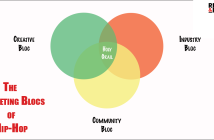Many questions are being posed regarding hip-hop’s decline from the mainstream and why it is currently struggling to be a top 3 genre in the country. Several reasons for this decline have also been provided over the years; the rappers; the audience; the media; and cultural acceptance.
With all these questions and postulations lingering around, I decided to check in on other members of the hip-hop industry to hear their takes. We all have these challenges in the industry. Once we can discover the root of these problems, solutions and their implementations aren’t far off.
Armed with these points, a Twitter Space for Hip-hop creatives was hosted to share their individual experiences in their respective hip-hop field and possible solutions to solve this Gordian knot. The session was attended by those in music, fashion, media, tech, and concerned fans of the culture. They all gave their 2cents on the State of the Culture and suggested ways to move it forward.
The Audience
Part of the decline was attributed to the audience’s taste; they’d rather listen to a foreign hip-hop artiste over an indigenous one. Some of the points raised here include; songs are not danceable, dumbing down lyrical prowess for vibes, etc.
Then again, an audience will always exist for whatever product you sell. Even products that are harmful to one’s health still have an audience; tobacco, tummy tuck, etc. It’s all about both you and your audience finding each other.
The Mainstream Media
The media is pivotal in determining who gets the most market share of everything; goods, services, messages, etc. The media’s reach and frequency of playing a song, music video, news coverage and PR rounds can make or break the career of artistes. An infectious song can get just one play during peak hours and instantly become a new sensation – going viral.
The existing mainstream media – traditional and digital – all seem to favour Afrobeat (pop and all derivative genres) with airplay, while the foreign hip-hop genre is ahead of local hip-hop music in the airplay queue. We understand that these outfits are all for-profit (payola inclusive), but the local media owe it to their local listeners the discovery of new artistes in their localities.
The deejays at clubs and mixtapes don’t break artistes anymore; they are all about featuring the mainstream acts and gathering a collection of ‘potential’ hit singles as an LP. By doing this, the media has killed the underground economy on all levels. If the media plays its part in serving up hip-hop artistes, their music, and other forms of news and gossip, the hip-hop genre would also have a market share it can always rely on since the audience now know where to find the latest, hottest and newest rap acts in the game.
The Uncooperative Hip-Hop Creatives Community
Another factor mentioned by members of the community – an Ol’G and a major label signed act – is the deceptions and lies in the industry (especially the mainstream), despite its small size.
Instances were given where a rapper would be approached for collaboration, and the rapper agrees to it and never picks up your calls or replies to your messages again. Another was a rapper declining a feature without even listening to your tape or song because you don’t match up to their standards; drip and bank balance.
Another angle is being blackballed or blacklisted in the industry because a particular “Gatekeeper” or “Chairman” is unhappy with you or felt slighted. Therefore, he must show you who’s boss by ensuring no mainstream act, producers, media, and management consider you for promotion regardless of how incredibly talented you might be. Yep! “Fragile EGOs”
Cultural Acceptance
The last point raised was the societal/cultural acceptance of the genre. To break it down, since we developed Afrobeat or pop, it is ours, unlike hip-hop. We took another culture’s musical culture and made it ours. Because we didn’t create it, time passed, and it faded into the scene.
This particular point is what I’m afraid I have to disagree with. Even the Afrobeats wasn’t originally ours; over time, with a mixture of indigenous cultural sounds and ingenious producers and musical acts, we came up with a version the world loves; same for the new revised Amanpiano-derived sound.
The same goes for hip-hop. In other countries, indigenous sounds have been included to create distinctions from the US. Moroccan hip-hop and French hip-hop are sounds you can identify whenever they come on. We need to rely on our creativity to develop a hip-hop sound that is ours.
CONCLUSION
With the four points raised, the media is the only one out of our control. As hip-hop culture creatives or enthusiasts, we can make a collective and intentional effort to create an ego-free, toxic-free space where collaborations are not an issue. Yes! Collaboration is a growth strategy that will continue to work until the end of time.
Big brands have collaborated to share each other’s market share; Nike Airforce 1 + Gucci, LV + Supreme, etc. If it works at that scale, why do we ignore/underestimate its relevance on a smaller scale? Collaborate with any and everyone you can collaborate with. You never know who’s next up to blow, and if you continue to give a 100% on every verse, you will get a new audience from everyone you’ve ever collaborated with.
Yes, most people will say money. Then again, a piece of royalty from all these features will have you making income before you even have your own single or project out there. Three featured verses a month equals 36 verses a year, and there’s no way 1 of these will not resonate with listeners; you are speaking their reality; you are speaking on their behalf. Thus, you’ve earned a new died hard fan that will follow you to the ends of the world.
It is also with collaborations new sounds that will be ours are developed. But to be fair, PH has a unique sound called CUTLASS MUSIC, pushed heavily by Murz – a cocktail of hip-hop, drill, trap, and local sounds. I’m also convinced other states have theirs already and only require exposure and discovery.
To grow an audience, collaborations are required by the existing media hip-hop outlets; magazines, blogs, playlist curators, podcasters, hip-hop influencers, battle rap groups, cypher groups, freestyle groups, etc. It seems we’ve all forgotten that the Hip-hop culture is a movement used to push for socio-political changes, not just a competition amongst its creatives and participants.
Like I always say, the audience is there; all they need is how to locate us. We need to make ourselves easier to find, and slowly but surely, we will groom a community worth raising an economy around.
I could go on and on about tips and cheap tricks that every creative, regardless of role – artistes, producer, deejays, b-boys, graffiti artists, engineers, content creators, fashion designers, fashion designers, photographers, videographers, tech gurus, animators etc., – can apply to achieve an advancement in their careers by contributing to the culture.
But first, we need an open ecosystem and community where creatives from all works of life can come together to share knowledge, experiences, and solutions to build a new hip-hop industry that benefits everyone – Underground or mainstream.
There’s nothing wrong with an up-and-coming act or creative in the industry bagging $50,000 to $100,000 annually by 2025, meaning the industry is worth over $500m by then. All by simply growing a community that works for everyone.
Let’s build a future for the hip-hop culture. Join the community




